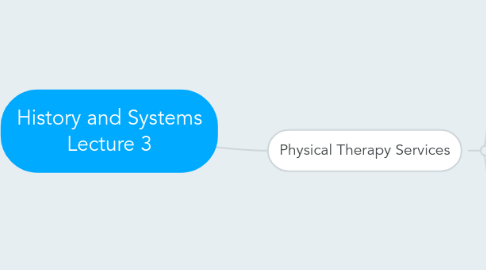
1. Physical Therapy Services
1.1. Chief complaints
1.1.1. Usually:
1.1.1.1. Lower back
1.1.1.2. Shoulder
1.1.1.3. Knee
1.1.2. Questioning should begin with chief complaint
1.1.2.1. What brings you here today?
1.1.2.2. I understand you are having trouble with your knee (or back or shoulder) - is that what brings you here today?
1.2. Follow-up questions
1.2.1. Do the chief symptoms move or spread up, down, or around you?
1.2.2. Can you rate your symptom intensity on a 0-10 scale?
1.2.3. Do you have symptoms anywhere else?
1.3. SINSS
1.3.1. Severity
1.3.1.1. Intensity of the patient's symptoms as they relate to functional activity
1.3.2. Irritability
1.3.2.1. The ease with which the symptoms can be provoked or stirred up
1.3.2.1.1. 3 components:
1.3.3. Nature of complaint
1.3.3.1. Term describes the clinician's assessment of the following:
1.3.3.1.1. Hypothesis of:
1.3.3.1.2. Anything about the problem or overall condition that may warrant caution with the objective examination
1.3.3.1.3. The character of the presenting patient or the problem
1.3.4. Stage of pathology
1.3.4.1. Stage at which the disorder is presenting
1.3.4.1.1. Acute
1.3.4.1.2. Subacute
1.3.4.1.3. Chronic
1.3.5. Stability
1.3.5.1. Progression of the patient's symptoms over time
1.3.5.1.1. Is the problem getting better, worse, or staying the same?
1.4. Examination process
1.4.1. Evaluation
1.4.1.1. Phase 1
1.4.1.1.1. Refer/consult
1.4.1.1.2. Diagnose and treat
1.4.1.1.3. Treat and refer
1.4.1.2. Phase 2
1.4.1.2.1. Diagnosis
1.4.1.2.2. Data organized into defined clusters, syndromes, or categories
1.4.1.3. Prognosis
1.4.1.4. Interventions
1.4.1.5. Outcomes
1.5. Symptom investigation
1.5.1. Subcategories of symptom location and description
1.5.2. History
1.5.2.1. Current or most recent episode
1.5.2.2. Impairment related
1.5.2.2.1. Traumatic event
1.5.2.2.2. Accident
1.5.2.2.3. Repetitive overuse
1.5.2.2.4. Sustained postural strains
1.5.2.3. Insidious onset?
1.5.2.4. Comparing and contrasting current with past events
1.5.3. Behavior or pattern of symptoms
1.5.3.1. Relationship of symptoms to:
1.5.3.1.1. Rest
1.5.3.1.2. Activities
1.5.3.1.3. Time of day
1.5.3.1.4. Positions/Postures
1.5.3.2. Constancy
1.5.3.3. Frequency
1.5.3.4. Duration
1.5.3.5. Fluctuations of intensity
1.5.3.6. Symptoms that move or start in different areas
1.5.3.7. Night pain
1.5.3.7.1. Follow-up questions
1.5.3.7.2. Other questions
1.5.3.8. Flags
1.5.3.8.1. Yellow flags
1.5.3.8.2. Red flags
1.5.4. Symptoms usually related to:
1.5.4.1. Sprain
1.5.4.2. Strain
1.5.4.3. Poor posture
1.5.4.4. Arthritic condition
1.6. Body diagrams
1.6.1. Helpful in noting the exact location of symptoms and describing
1.6.2. Include:
1.6.2.1. Quality
1.6.2.2. Paresthesia
1.6.2.3. Numbness
1.6.2.4. Weakness
1.6.3. Note where the patient does and does not have pain
1.7. Visceral local and referred pain
1.7.1. See slide 11 for diagram
1.7.2. Vascular
1.7.2.1. Throbbing
1.7.2.2. Pounding
1.7.2.3. Pulsating
1.7.2.4. Beating
1.7.3. Neurogenic pain
1.7.3.1. Sharp
1.7.3.2. Crushing
1.7.3.3. Pinching
1.7.3.4. Burning
1.7.3.5. Hot
1.7.3.6. Searing
1.7.3.7. Itchy
1.7.3.8. Stinging
1.7.3.9. Pulling
1.7.3.10. Jumping
1.7.3.11. Shooting
1.7.3.12. Electrical
1.7.3.13. Gnawing
1.7.3.14. Pricking
1.7.4. Visceral
1.7.4.1. Aching
1.7.4.2. Squeezing
1.7.4.3. Gnawing
1.7.4.4. Burning
1.7.4.5. Cramping
1.7.4.6. Colicky
1.7.5. Musculoskeletal
1.7.5.1. Aching
1.7.5.2. Sore
1.7.5.3. Heavy
1.7.5.4. Hurting
1.7.5.5. Deep
1.7.5.6. Cramping
1.7.5.7. Dull

